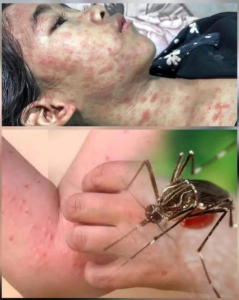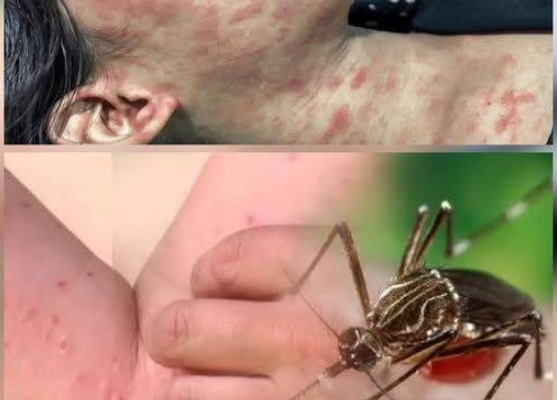
A new health alert has shaken the global community as Chinese health authorities report a sudden and fast-moving outbreak of a mosquito-borne disease in the southern region of the country. More than 7,000 cases have been recorded, with the majority coming from Guangdong province, particularly the city of Foshan. The disease behind this surge is Chikungunya, a viral infection transmitted primarily through the bite of infected Aedes mosquitoes. Though the illness is rarely fatal, it can cause intense fever, severe joint pain, and significant disruption to daily life. As global travel and trade remain highly interconnected, experts are watching this outbreak closely, concerned about its potential to spread beyond China.
The disease has a reputation for rapid transmission in warm, humid environments where Aedes mosquitoes thrive. These mosquitoes breed in stagnant water and are most active during the day, particularly in the early morning and late afternoon. Because Guangdong is one of China’s most densely populated and industrially active provinces, its environmental conditions and urban landscape make it an ideal setting for mosquito breeding if not well controlled. Public health officials have already confirmed that multiple neighborhoods are affected, and hospitals in the region have seen a spike in patients with fever and joint pain.
Chikungunya typically begins suddenly after an incubation period of two to seven days. The first symptom is usually a high fever, often accompanied by severe pain in the joints, particularly in the hands, wrists, ankles, and knees. Many patients also experience headaches, muscle pain, rashes, and extreme fatigue. While most people recover fully after a couple of weeks, some experience lingering joint pain that can last for months. This post-viral joint pain can be debilitating, especially in older adults or those with weakened immune systems. Children, the elderly, and people with underlying conditions are more vulnerable to complications.
One key fact is that the virus is not spread from person to person through the air, as happens with influenza or COVID-19. Instead, mosquitoes pick up the virus when they bite an infected person during the first few days of illness, then transmit it to another person through a subsequent bite. This means that containing mosquito populations is critical to stopping the outbreak. In Guangdong, local authorities have launched large-scale mosquito-control campaigns. Fogging operations are underway in neighborhoods with reported clusters of cases. Communities are being urged to empty containers of standing water, cover water storage units, and use insect repellents and nets.
China’s Centers for Disease Control has also advised people in affected areas to stay indoors during peak mosquito activity and to wear long sleeves and pants when outside. Travel advisories have been issued for domestic travelers, asking them to be alert to symptoms if they have recently visited Guangdong. International health organizations are also monitoring the situation, given the risk of exportation through travelers. Since Aedes mosquitoes are present in many parts of Asia, Africa, the Americas, and parts of Europe, experts are concerned that infected travelers could spark local transmission in other countries with similar climates.
The outbreak has put pressure on healthcare facilities in the affected regions. Doctors and nurses are working long hours to care for patients with fever and severe joint pain. There is currently no specific antiviral medication for chikungunya. Treatment is focused on rest, hydration, and pain management using medications like acetaminophen. Health experts advise against using non-steroidal anti-inflammatory drugs like aspirin or ibuprofen during the early stages of illness, as these can complicate the diagnosis in regions where dengue fever may also be circulating. Both dengue and chikungunya share similar symptoms, and laboratory testing is often required to confirm the diagnosis.
The Guangdong outbreak is not the first major chikungunya event in Asia. The disease has caused numerous outbreaks in tropical and subtropical regions over the past few decades. It originated in Africa and spread across Asia and the Americas in waves, often causing sudden spikes in cases during hot seasons. The virus is known for its ability to overwhelm communities quickly because of how efficiently Aedes mosquitoes transmit it. When large populations are infected at the same time, hospitals can become strained, workforces are impacted, and local economies may suffer short-term disruptions.
Authorities are particularly concerned about the potential for this outbreak to coincide with other mosquito-borne illnesses. Southern China is already a region that experiences periodic cases of dengue fever, and the co-circulation of multiple viruses can complicate control measures. Mosquito-control programs must be carefully planned and sustained over weeks or months to be effective. In the current outbreak, officials are combining aerial spraying with ground-level clean-up campaigns. Residents are encouraged to actively participate, as community involvement is essential in controlling the mosquito population.
For individuals in or near the affected areas, prevention is the best protection. Experts recommend using mosquito repellents containing DEET or picaridin, wearing protective clothing, and ensuring living spaces are fitted with screens or nets to keep mosquitoes out. People are also advised to sleep under mosquito nets, especially in areas without air conditioning. Emptying buckets, flower pots, birdbaths, and other containers that can collect rainwater is a simple but effective step in reducing mosquito breeding sites. Even a bottle cap filled with water can serve as a breeding ground for hundreds of mosquitoes in just a few days.
Another critical step is seeking medical care early if symptoms appear. Fever and joint pain that develop within a week of being in an outbreak area should not be ignored. Early diagnosis helps health authorities track the spread and apply mosquito-control measures more effectively. People who test positive should also try to avoid mosquito bites during their infectious period to reduce the chance of further transmission. This includes resting indoors, using repellents, and sleeping under a net.
Globally, health agencies such as the World Health Organization and the U.S. Centers for Disease Control and Prevention are monitoring the outbreak closely. Neighboring countries are being advised to strengthen mosquito surveillance and prepare for possible imported cases. Travelers from China who develop symptoms after returning home may be asked to undergo testing to confirm or rule out chikungunya. As of now, there are no border restrictions or travel bans in place, but the situation remains under review.
Experts say that while the outbreak is serious, it is manageable with proper mosquito control and community cooperation. Unlike some other emerging diseases, chikungunya does not typically result in large numbers of deaths, but it can have a significant impact on quality of life and local healthcare systems. The key is early action, both at the government and community level.
The situation in Guangdong continues to evolve, and health authorities are expected to provide regular updates as new case numbers come in. People are encouraged to rely on credible sources for information rather than rumors or unverified claims online. As mosquito-borne diseases continue to emerge in different parts of the world due to changing climates and rapid urbanization, outbreaks like this one serve as a reminder of how crucial public health measures and preparedness can be.
In short, the outbreak of chikungunya in southern China is a major public health event, but not an uncontrollable one. With over 7,000 cases already reported, strong mosquito-control efforts, public cooperation, and international monitoring will be essential to contain the virus. People in affected areas can protect themselves through simple preventive actions: use repellent, wear protective clothing, eliminate breeding sites, and seek care early if sick. The coming weeks will be critical, but with decisive measures, the spread of the disease can be slowed, and lives can be protected

